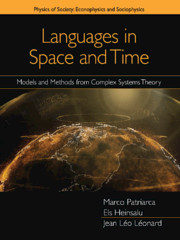Chapter 5 - Introduction to Language Dynamics
Published online by Cambridge University Press: 04 June 2020
Summary
In this chapter, some mathematical models of language dynamics (Wichmann,2008a,b; Schulze et al., 2008; Vogt, 2009; Castellano et al., 2009;Solé et al., 2010) are discussed and illustrated with someapplications. Many language dynamics models have been developed to describe,for example, the evolution of languages, the competition processes betweendifferent linguistic features (considered as fixed entities), or thecognitive dimension of language. Due to limited space, it is not possible toprovide here an exhaustive discussion of language dynamics models and manyimportant pieces of the complete picture of the field are missing. In thefollowing sections, we will discuss a selection of examples with the goal ofproviding at least a general idea of the field and why it represents aframework for further possible developments.
The ultimate goal of mathematical language dynamics models is to provide aquantitative description of language change, that is, of the combineddynamics of evolution, competition, and spreading processes of languages inspace and time and of the consequent diversity and correlations of thelinguistic landscapes, discussed in the first part of the book. Forconvenience, models are classified into different types. Fully evolutionarymodels, in which languages themselves undergo changes, while possiblycompeting with each other, are discussed in Chapter 6. Competition andnatural selection models, which consider the processes taking place on ashorter time scale, and on which language features can be considered fixed,are discussed in Chapter 7; they can in turn be classified into modelsstudying the time scale of language shifts and those focusing on the shortertime scale of language use. We explore the important and interestingcognitive dimension of language only partially, by reviewing a few semioticdynamics models, which are discussed in Section 6.1.
Motivations behind Language Dynamics Modeling
There are different motivations that drive the study of language dynamics,ranging from scientific to social ones. These diverse motivations reveal theinterdisciplinary nature and wide applicability range of languagedynamics.
• Language represents one of the most complex known phenomena.This fuels the interest of scientists who are keen to solvelife's every problem, be it complex or simple.
- Type
- Chapter
- Information
- Languages in Space and TimeModels and Methods from Complex Systems Theory, pp. 97 - 109Publisher: Cambridge University PressPrint publication year: 2020



